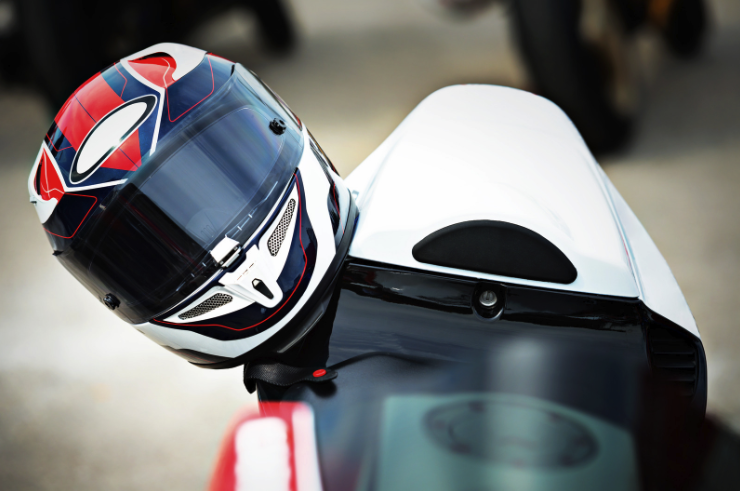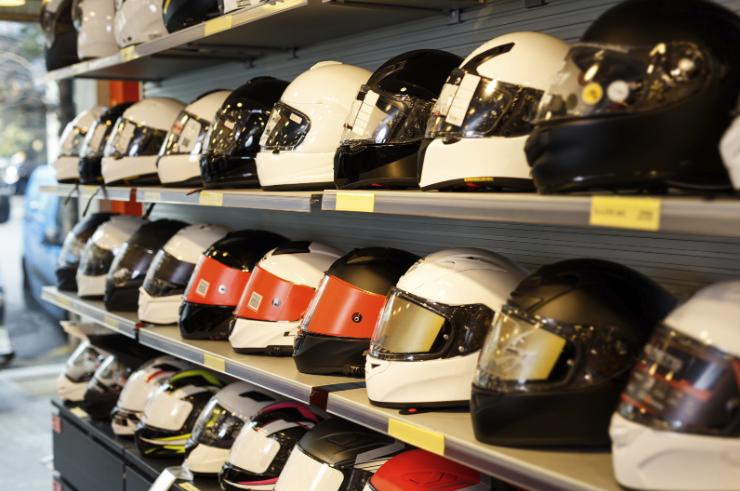Prioritizing safety is key when riding a motorcycle in New Zealand. This means getting the best gear, particularly a helmet, which is crucial for protection. The variety of options can be overwhelming but fear not! Here’s an all-inclusive guide to help you choose the most reliable and suitable motorcycle helmet NZ riders can depend on based on their preferences regarding style and budget as well as needs towards security measures.
Understanding Motorcycle Helmet Types
In order to provide targeted advice, it is crucial to first comprehend the varying categories of motorcycle helmets that are currently obtainable.
Full-Face Helmets
The level of protection provided by full-face helmets is widely recognized as unparalleled among all helmet types. These helmets cover the entire head, including both chin and face areas, creating a sturdy shield that effectively guards against impacts and abrasions. To gain a better understanding of their advantages, let’s take an in-depth look into their features.
- Coverage and Protection: The design of full-face helmets aims to provide complete coverage to ensure optimal protection during accidents or falls. This all-encompassing shield safeguards not just the cranium but also essential facial features such as the chin, nose, and eyes.
- Safety Standards: Organizations like DOT and ECE set rigorous safety standards that full-face helmets often meet, thanks to their wide coverage. Such certifications guarantee the rider protection from significant impacts, making these helmets a reliable choice.
- Impact Absorption: Full-face helmets are usually constructed using various layers of impact-absorbing components, including EPS (Expanded Polystyrene) foam and a durable outer casing. This blend effectively disperses force from collisions, thereby minimizing the likelihood of head injuries.
- Ventilation Systems: Full-face helmets often incorporate sophisticated ventilation systems to avoid misting and enhance comfort. These setups typically entail air intakes at the front, coupled with exhaust vents positioned towards the back, resulting in a steady influx of cooling air that enhances breathability while keeping the rider’s head cool.
- Visor Options: There are various visor options available for full-face helmets, including clear ones that ensure perfect visibility in all weather conditions and tinted or photochromic alternatives that adapt to shifts in light. Additionally, certain helmets feature advanced safety measures such as anti-fog and anti-scratch coatings on their visors for improved robustness and clarity of vision.
Open-Face Helmets (3/4 Helmets)
Open-face helmets, also known as 3/4 helmets, strike a balance between protection and ventilation. They cover the top, sides, and back of the head while leaving the face open. This style is popular among riders who prioritize comfort and visibility:
- Design and Comfort: Open-face helmets are favored for their lightweight and breathable design. They provide excellent airflow, making them ideal for warm-weather riding. The open-face design also allows riders to feel more connected to their surroundings compared to full-face helmets.
- Visibility and Field of Vision: One of the key advantages of open-face helmets is their wide field of vision. Riders benefit from unobstructed peripheral vision, which enhances situational awareness, particularly in urban or congested riding environments.
- Ease of Use: Open-face helmets are easier to put on and take off compared to full-face helmets, making them convenient for short rides or frequent stops. This accessibility is particularly valued by scooter riders and commuters who may need to remove their helmets intermittently.
- Style and Customization: These helmets often come in a variety of styles and designs, allowing riders to express their individuality. Some models feature retro-inspired designs with leather accents or chrome trim, appealing to riders seeking a classic aesthetic.
Modular Helmets
Modular helmets combine the versatility of full-face and open-face designs with a unique flip-up chin bar. This innovative feature allows riders to switch between full-face and open-face configurations:
- Flexibility and Versatility: Modular helmets offer unmatched versatility, allowing riders to adapt to changing riding conditions or preferences. With the ability to flip up the chin bar, riders can enjoy the protection of a full-face helmet during highway riding and the convenience of an open-face helmet during city cruising or pit stops.
- Convenience and Accessibility: The flip-up chin bar facilitates easier communication, eating, or drinking without the need to remove the entire helmet. This convenience is particularly beneficial for touring riders who may spend extended hours on the road.
- Safety Considerations: When the chin bar is securely locked in the closed position, modular helmets provide comparable protection to traditional full-face helmets. It’s essential for riders to ensure that the chin bar mechanism meets safety standards and remains securely fastened during rides.
- Ventilation and Comfort: Like full-face helmets, modular helmets often feature advanced ventilation systems to maintain airflow and reduce heat buildup. Riders can adjust intake and exhaust vents to enhance comfort, especially during long-distance rides or variable weather conditions.
Off-Road Helmets
Off-road helmets are purpose-built for dirt biking, motocross, and other off-road riding disciplines where rugged protection and enhanced visibility are paramount:
- Design and Construction: Off-road helmets feature a distinct aerodynamic shape with an elongated chin bar and a pronounced visor. These design elements are engineered to deflect debris, mud, and branches encountered during off-road adventures.
- Impact Protection: The construction of off-road helmets prioritizes lightweight materials that offer superior impact absorption and durability. High-quality EPS foam liners and reinforced outer shells help mitigate the force of impacts, safeguarding riders from head injuries.
- Ventilation and Cooling: Off-road helmets are equipped with extensive ventilation systems to manage heat and humidity. Strategically placed vents allow for optimal airflow, preventing overheating during intense off-road maneuvers and maintaining rider comfort.
- Goggle Compatibility: To provide comprehensive eye protection, off-road helmets are designed to accommodate goggles. Goggles offer additional defense against dust, dirt, and debris, ensuring clear vision in challenging off-road conditions.
Factors to Consider When Choosing a Motorcycle Helmet

Choosing the best motorcycle helmet NZ offers involves considering several important factors:
Safety Standards
Ensuring your helmet meets New Zealand safety standards is paramount to guaranteeing adequate protection in the event of accidents. Look for helmets certified under AS/NZS 1698:2006, which establishes the minimum performance requirements for motorcycle helmets in New Zealand.
- Certification: Check for the AS/NZS 1698:2006 certification label inside the helmet to confirm compliance with local safety standards.
- Additional Certifications: Consider helmets with additional certifications like SNELL or DOT (Department of Transportation) for added safety assurance, especially if planning to ride in other regions or countries with specific safety standards.
Fit and Comfort
A properly fitting helmet not only enhances safety by ensuring proper coverage and stability but also contributes significantly to comfort during short commutes or long rides.
- Head Size Measurement: Begin by measuring your head size accurately using a flexible measuring tape. Helmets come in various sizes, so consult the manufacturer’s size chart to determine the best fit.
- Fit Testing: Once you have selected a helmet size, try it on to assess its fit. The helmet should feel snug around your head without causing discomfort or pressure points. It should sit level on your head, covering the top of your forehead and resting just above your eyebrows.
- Retention System: Check the helmet’s retention system, typically a chin strap with a secure fastening mechanism, to ensure it can be adjusted for a snug and secure fit.
Ventilation and Airflow
Effective ventilation is crucial, especially during warm weather or extended rides, to prevent discomfort from heat buildup inside the helmet.
- Ventilation System: Look for helmets designed with multiple vents strategically placed to promote airflow. These vents should allow cool air to enter and warm, moist air to exit, maintaining a comfortable internal temperature.
- Adjustable Vents: Consider helmets equipped with adjustable vents that can be opened or closed to regulate airflow based on weather conditions and your personal preference. This feature allows you to stay cool during hot days and close vents to retain warmth in cooler weather.
Weight
The weight of the helmet impacts both comfort and fatigue levels, particularly during extended rides where neck strain can become an issue.
- Materials: Opt for helmets constructed from lightweight materials such as carbon fiber, fiberglass, or advanced polycarbonate blends. These materials offer strength and impact resistance while minimizing overall weight.
- Comfort: Lighter helmets reduce the strain on your neck muscles, allowing you to ride comfortably for longer durations without experiencing undue fatigue. Consider the balance between weight and other features when selecting your helmet.
Visor Options
Visors are essential for visibility and eye protection, offering features that enhance safety and comfort in various riding conditions.
- Anti-fog Coatings: Choose helmets with visors treated with anti-fog coatings to maintain clear vision in humid or cold weather conditions. These coatings prevent condensation from forming on the visor, ensuring optimal visibility without distractions.
- UV Protection: Look for visors equipped with UV protection to shield your eyes from harmful ultraviolet rays emitted by the sun. UV protection reduces glare and eye strain, enhancing your ability to see clearly and maintain focus on the road ahead.
Top Picks for Motorcycle Helmets in New Zealand

Now, let’s explore some of the best motorcycle helmets available in New Zealand across different styles and price ranges:
Full-Face Helmets
Full-face helmets are renowned for offering the most extensive coverage and protection, enveloping the entire head and face. This design is pivotal for its safety benefits, significantly reducing the risk of facial injuries in accidents. These helmets are equipped with a fixed chin bar and are preferred by riders who prioritize safety and ride in varied conditions, from urban environments to high-speed tracks.
| Helmet Model | Features | Safety Features | Price Range |
| Shoei GT-Air II | Incorporates a premium build quality with outstanding ventilation systems and comfort padding, designed to provide optimal noise reduction and airflow. | Equipped with a multi-density EPS liner and a reinforced shell structure for enhanced impact absorption. | NZD 900 – NZD 1100 |
| AGV K6 | Exceptionally lightweight and aerodynamically designed for high-speed performance, this helmet offers an aggressive style combined with superior noise isolation. | Features a high-resistance thermoplastic resin shell and includes a hygienically treated interior liner. | NZD 700 – NZD 900 |
Open-Face Helmets
Open-face helmets, also known as “three-quarters” helmets, offer substantial protection for the back and sides of the head but leave the face exposed, which enhances visibility and makes communication easier. This type is particularly popular among urban riders, scooter enthusiasts, and those who prefer less confined riding experiences.
| Helmet Model | Features | Safety Features | Price Range |
| Bell Custom 500 | A modern reinterpretation of the classic design, integrating contemporary safety enhancements with a customizable fit for various head shapes. | Features a fiber composite shell and a multi-density EPS liner that meets modern safety standards. | NZD 200 – NZD 300 |
| Shark S-Drak | Stylish urban helmet with a distinctive removable mask and an ergonomically designed inner lining that prioritizes comfort and fit. | Constructed with a slim-fit shell that includes multiple density EPS for improved shock absorption. | NZD 300 – NZD 400 |
Modular Helmets
Modular helmets offer a hybrid solution, combining the full coverage of full-face models with the convenience of an open-face helmet thanks to their flip-up chin bar. These helmets are highly versatile, appealing to touring riders who may face varying conditions and need to easily switch between full and open face configurations without removing the helmet.
| Helmet Model | Features | Safety Features | Price Range |
| Nolan N100-5 | Features a robust design with a flip-up mechanism, allowing transitions without compromising on safety. The helmet is designed for long rides, providing comfort through extended wear. | Includes a dual-action chin bar release, an integrated sun shield, and a pinlock fog-resistant system. | NZD 600 – NZD 800 |
Off-Road Helmets
Off-road helmets are designed specifically for adventure and motocross riders, featuring enhanced ventilation and protection suited for rough terrains and competitive environments. These helmets are lightweight and often incorporate advanced technologies to manage the impacts of high-speed and high-intensity riding.
| Helmet Model | Features | Safety Features | Price Range |
| Fox Racing V3 RS | This helmet integrates MIPS technology, focusing on reducing rotational forces during impacts. It includes features like a magnetic visor release system (MVRS) to manage forces from angular and rotational impacts. | Equipped with an advanced shell construction and an EPS liner that enhances safety and comfort. The removable liner makes it easy to clean and maintain hygiene. | NZD 700 – NZD 900 |
Conclusion
Choosing the best motorcycle helmet NZ riders can rely on involves considering your riding style, safety needs, and personal preferences. Whether you opt for a full-face, open-face, modular, or off-road helmet, prioritize comfort and fit above all else. Invest in a helmet that meets New Zealand safety standards and suits your budget to ensure a safe and enjoyable riding experience.
By following this guide, you’ll be well-equipped to make an informed decision and find the perfect helmet for your motorcycle adventures in New Zealand. Stay safe, ride responsibly, and enjoy the open road with confidence in your gear.
FAQ
A: A properly fitting helmet should feel snug but not tight. It should sit level on your head with the top of the eye port just above your eyebrows.
A: Not necessarily. While higher-priced helmets often come with advanced features and materials, all helmets sold in New Zealand must meet safety standards to provide adequate protection.
A: Manufacturers recommend replacing your helmet every 5 to 7 years, depending on usage and exposure to elements that can degrade its materials.
A: It’s not recommended. Motorcycle helmets are designed specifically for motorcycling and may not provide adequate protection for other sports.
A: Clean the outer shell with mild soap and water. Inner liners can often be removed and hand-washed. Avoid using harsh chemicals or solvents.
